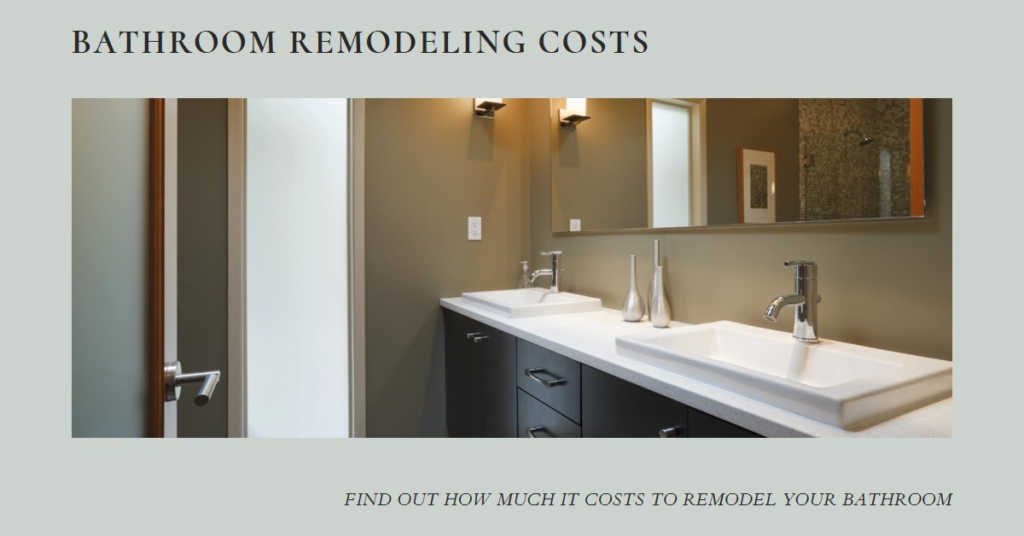
Table of Contents
Embarking on a bathroom remodeling project involves careful planning, budgeting, and consideration of various factors that influence the overall cost. From design choices to material selections and labor expenses, understanding the key components of bathroom remodeling costs empowers homeowners to make informed decisions and achieve desired results within their budgetary constraints. In this comprehensive guide, we’ll delve into the intricacies of bathroom remodeling costs, providing valuable insights and tips for a successful renovation project.
1. Assessing Project Scope and Goals
The first step in estimating bathroom remodeling costs is to assess the scope of your project and define your renovation goals clearly. Determine whether you’re looking for a cosmetic refresh, a functional upgrade, or a complete overhaul of your bathroom space. Identify specific areas such as fixtures, cabinetry, flooring, lighting, plumbing, and electrical systems that require attention. Clearly outlining your project scope and goals helps you prioritize expenditures, allocate budgets accordingly, and communicate effectively with contractors or designers.
2. Budget Allocation and Contingency Planning
Establishing a realistic budget for your bathroom remodel involves allocating funds to different project components while factoring in unexpected expenses and contingencies. Allocate a significant portion of your budget to essential elements such as plumbing, electrical work, waterproofing, and structural modifications to ensure safety, compliance, and functionality. Reserve a contingency fund of around 10-20% of your total budget to address unforeseen challenges, design changes, or hidden issues that may arise during the remodeling process, mitigating financial stress and project delays.
3. Understanding Material Costs and Quality
Material selections significantly impact overall bathroom remodeling costs, with options ranging from budget-friendly basics to premium, luxury materials. Research and compare material costs for tiles, countertops, cabinetry, fixtures, lighting, hardware, and accessories based on quality, durability, and design aesthetics. Consider long-term maintenance, water resistance, and style compatibility when choosing materials to achieve a balance between cost-effectiveness and visual appeal. Opting for durable, low-maintenance materials may entail higher initial costs but can save on future repair and replacement expenses, enhancing overall value and longevity of your bathroom design.
4. Evaluating Labor Costs and Professional Services (Remodel)
Labor costs for bathroom remodeling projects vary based on project complexity, labor rates in your area, contractor experience, and scope of work. Obtain multiple quotes from licensed and reputable contractors or remodeling professionals after sharing your project plans, specifications, and desired timelines. Compare labor estimates, services included, project schedules, and warranties to make informed hiring decisions aligned with your budget and quality expectations. Hiring skilled professionals ensures craftsmanship, code compliance, and project management expertise essential for successful and stress-free remodels.
5. Plumbing and Electrical Considerations
Upgrading or relocating plumbing fixtures, pipes, drains, and electrical systems as part of your bathroom remodel requires careful planning, permitting, and coordination with licensed plumbers and electricians. Budget for plumbing modifications, fixture installations, waterproofing measures, and electrical upgrades such as GFCI outlets, lighting fixtures, ventilation fans, and heating elements as needed for safety, functionality, and comfort. Factor in labor costs, materials, permits, and inspection fees associated with plumbing and electrical work within your overall remodeling budget.
Your design choices and style preferences significantly influence the cost of your bathroom remodel, ranging from basic and functional designs to luxurious spa-like retreats. Consider elements such as layout changes, custom cabinetry, decorative tile patterns, freestanding tubs, shower enclosures, vanities, mirrors, and lighting designs that align with your aesthetic vision and lifestyle needs. Balance design aspirations with budgetary realities by prioritizing focal points, investing in key design elements, and exploring cost-effective alternatives or design compromises without compromising quality or aesthetics.
7. Permitting and Regulatory Compliance
Bathroom remodeling projects often require building permits, inspections, and regulatory compliance with local building codes, zoning ordinances, and safety standards. Budget for permit fees, architectural drawings, engineering reports, and inspections necessary for structural changes, plumbing alterations, electrical upgrades, and other construction activities. Engage with professionals familiar with local building regulations and permit processes to ensure project legality, quality assurance, and homeowner protection throughout the remodeling journey.
8. Fixture and Appliance Selections
Upgrading bathroom fixtures, appliances, and accessories such as faucets, sinks, toilets, showers, bathtubs, towel warmers, and storage solutions adds functional value and aesthetic appeal to your remodel. Research product options, brands, features, warranties, and energy efficiency ratings to make informed choices that align with your budget and performance expectations. Consider water-saving fixtures, smart technologies, and eco-friendly options that promote sustainability and long-term cost savings in utility bills and maintenance.
9. Demolition, Waste Disposal, and Cleanup Costs
Demolition of existing bathroom elements, waste disposal, and cleanup are essential phases of the remodeling process that entail labor, equipment, and disposal fees. Budget for demolition services, dumpster rentals, debris removal, and site cleanup to maintain a safe, organized, and efficient work environment throughout the remodel. Coordinate with contractors to schedule demolition and cleanup activities strategically, minimizing disruptions and ensuring proper disposal of construction debris and hazardous materials in compliance with environmental regulations.
10. Project Management and Timeline Considerations


Effective project management, scheduling, and timeline adherence are crucial for a smooth and timely bathroom remodel. Allocate resources for project management fees, permits, inspections, material deliveries, subcontractor coordination, and unexpected delays that may impact project timelines and completion dates. Communicate proactively with your remodeling team, establish clear milestones, and maintain open dialogue to address any challenges, changes, or design revisions promptly, optimizing workflow efficiency and project outcomes within your budgetary and timeline constraints.
In conclusion, estimating and managing bathroom remodeling costs involve a comprehensive understanding of project scope, material choices, labor considerations, design preferences, regulatory requirements, and project management essentials. By conducting thorough research, obtaining multiple quotes, prioritizing key elements, and planning for contingencies, homeowners can navigate the remodeling process confidently, achieve desired design outcomes, and enhance the functionality, aesthetics, and value of their bathroom spaces effectively.



